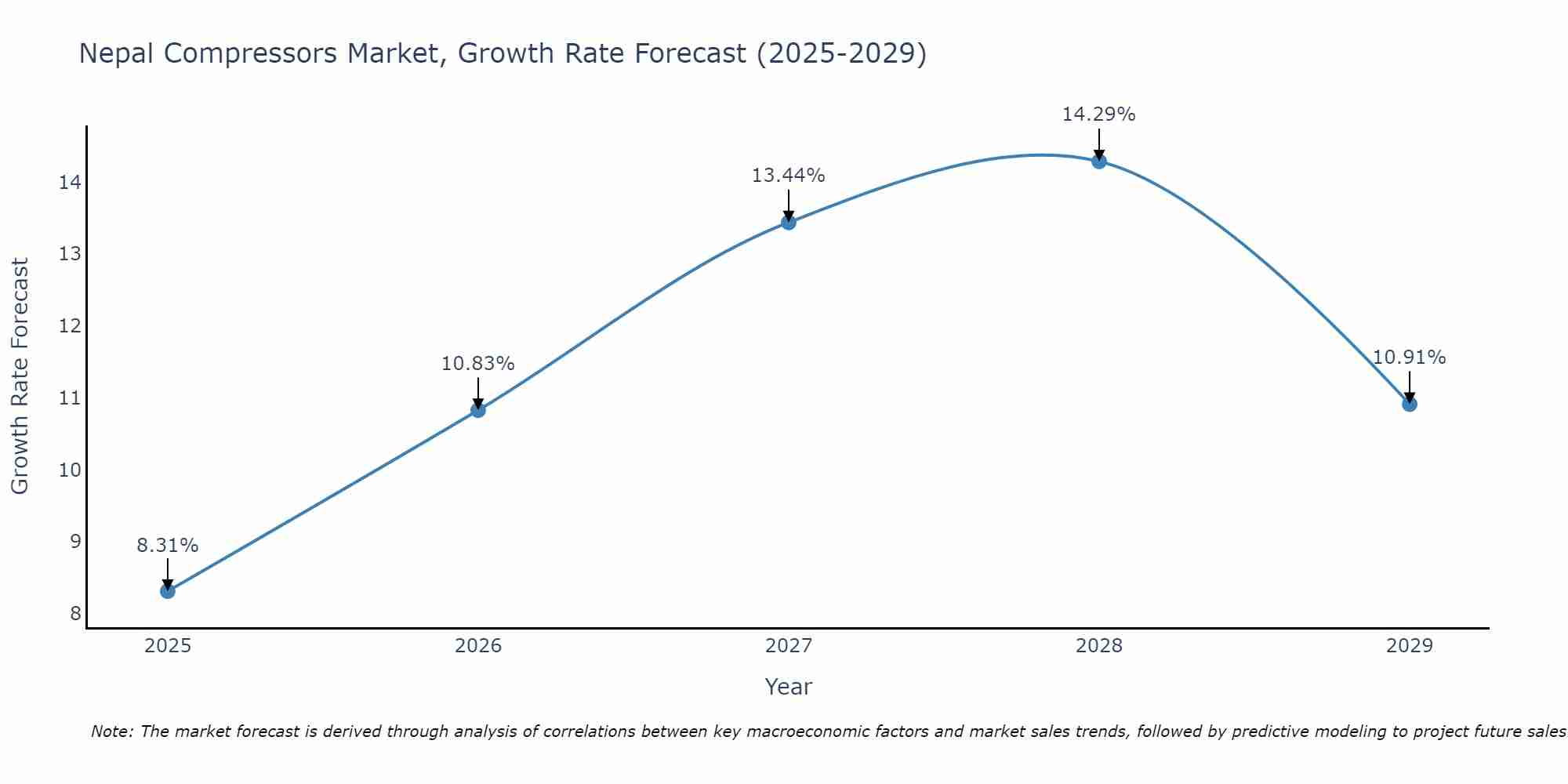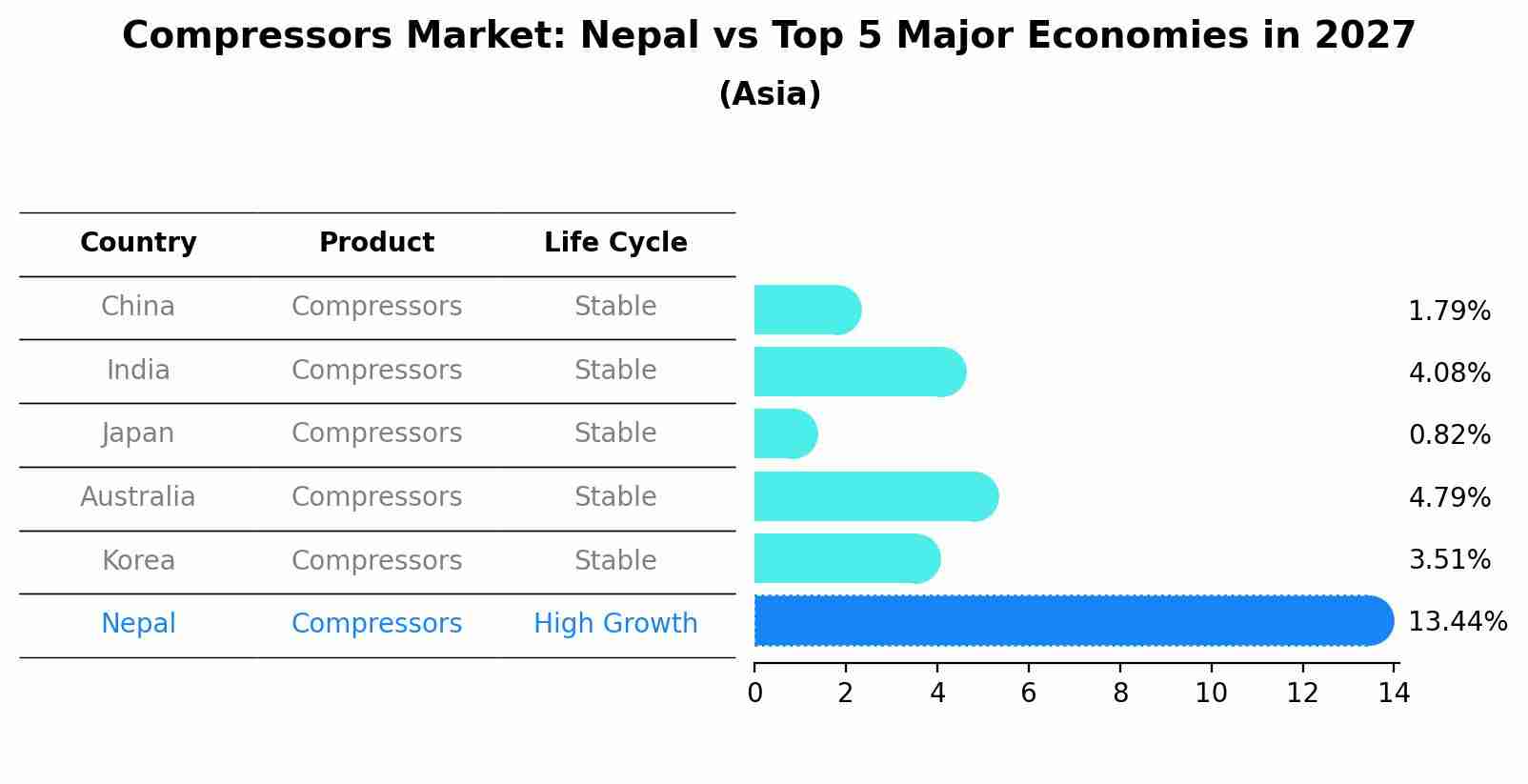Nepal Compressors Market (2025-2031) | Analysis, Companies, Size, Share, Revenue, Forecast, Industry, Outlook, Value, Growth & Trends
| Product Code: ETC023756 | Publication Date: Oct 2020 | Updated Date: Jun 2025 | Product Type: Report | |
| Publisher: 6Wresearch | Author: Summon Dutta | No. of Pages: 70 | No. of Figures: 35 | No. of Tables: 5 |
Nepal Compressors Market Size Growth Rate
The Nepal Compressors Market is projected to witness mixed growth rate patterns during 2025 to 2029. Growth accelerates to 14.29% in 2028, following an initial rate of 8.31%, before easing to 10.91% at the end of the period.

Compressors Market: Nepal vs Top 5 Major Economies in 2027 (Asia)
By 2027, Nepal's Compressors market is forecasted to achieve a high growth rate of 13.44%, with China leading the Asia region, followed by India, Japan, Australia and South Korea.

Nepal Compressors Market Overview
The Nepal compressors market is witnessing steady growth driven by increasing industrialization, infrastructure development, and rising demand for compressed air in various sectors such as manufacturing, construction, and automotive. The market is characterized by the presence of both domestic and international compressor manufacturers offering a wide range of products including reciprocating, rotary screw, and centrifugal compressors. Factors such as improving energy efficiency, advancements in technology, and government initiatives promoting industrial growth are further fueling market expansion. However, challenges such as high initial investment costs and maintenance requirements hinder market growth. Overall, the Nepal compressors market is expected to continue its growth trajectory, driven by increasing demand for compressed air solutions across diverse industries.
Nepal Compressors Market Trends
The Nepal compressors market is experiencing significant growth due to the increasing demand from various industries such as manufacturing, construction, and automotive. The market is witnessing a shift towards energy-efficient and environmentally friendly compressors as companies focus on sustainability and cost-effectiveness. Additionally, the rise in infrastructure development projects, coupled with the growing automotive sector, is driving the demand for compressors in the country. The market is also seeing a trend towards digitalization and automation in compressor technology to enhance efficiency and performance. Overall, the Nepal compressors market is poised for steady growth in the coming years, with a focus on innovation, sustainability, and technological advancements shaping the industry landscape.
Nepal Compressors Market Challenges
In the Nepal compressors market, several challenges are prevalent. One major challenge is the lack of awareness and knowledge about the benefits and applications of compressors among potential customers. This results in a slower adoption rate and limited market growth. Additionally, the inconsistent power supply and infrastructure issues in Nepal pose challenges for the reliable operation of compressors, affecting their efficiency and performance. Moreover, the presence of counterfeit products in the market leads to concerns about product quality and reliability, impacting the reputation of legitimate compressor manufacturers. Addressing these challenges through targeted marketing campaigns, improving infrastructure, and implementing stricter regulations on product quality can help overcome these obstacles in the Nepal compressors market.
Nepal Compressors Market Investment Opportunities
In the Nepal Compressors Market, there are several investment opportunities that investors can consider. One potential opportunity lies in the growing demand for compressors across various industries such as manufacturing, construction, automotive, and healthcare in Nepal. Investing in compressor manufacturing companies or distributors that cater to these sectors could be lucrative. Additionally, with the increasing focus on renewable energy and sustainability, there is a rising demand for energy-efficient compressors in Nepal. Investors could explore opportunities in companies that are developing and supplying eco-friendly compressor solutions. Moreover, as Nepal continues to develop its infrastructure and industrial base, there is a growing need for reliable and high-quality compressors, presenting opportunities for foreign manufacturers to enter the market through partnerships or joint ventures with local businesses.
Nepal Compressors Market Government Policy
The Nepal government has implemented several policies related to the compressors market to promote domestic production and reduce dependency on imports. These policies include providing subsidies and incentives to local compressor manufacturers, imposing tariffs on imported compressors to protect domestic products, and encouraging research and development in the sector through funding and support. Additionally, the government has introduced regulations to ensure quality standards are met by manufacturers and to promote sustainable practices in compressor production. These policies aim to boost the competitiveness of the domestic compressors market, create employment opportunities, and contribute to the overall growth of the manufacturing sector in Nepal.
Nepal Compressors Market Future Outlook
The Nepal compressors market is poised for steady growth in the coming years, driven by increasing industrialization, infrastructure development, and the expansion of the manufacturing sector. The demand for compressors is expected to rise across various applications such as automotive, construction, healthcare, and food and beverage industries. Additionally, the growing focus on energy efficiency and sustainability is likely to propel the adoption of advanced compressor technologies in the market. Government initiatives to promote local manufacturing and investment in key sectors are also expected to boost the demand for compressors in Nepal. Overall, the market is anticipated to witness a positive trajectory with opportunities for both local and international compressor manufacturers to cater to the evolving needs of the Nepalese market.
Key Highlights of the Report:
- Nepal Compressors Market Outlook
- Market Size of Nepal Compressors Market, 2024
- Forecast of Nepal Compressors Market, 2026
- Historical Data and Forecast of Nepal Compressors Revenues & Volume for the Period 2021 - 2031
- Nepal Compressors Market Trend Evolution
- Nepal Compressors Market Drivers and Challenges
- Nepal Compressors Price Trends
- Nepal Compressors Porter's Five Forces
- Nepal Compressors Industry Life Cycle
- Historical Data and Forecast of Nepal Compressors Market Revenues & Volume By Type for the Period 2021 - 2031
- Historical Data and Forecast of Nepal Compressors Market Revenues & Volume By Positive Displacement for the Period 2021 - 2031
- Historical Data and Forecast of Nepal Compressors Market Revenues & Volume By Dynamic for the Period 2021 - 2031
- Historical Data and Forecast of Nepal Compressors Market Revenues & Volume By Industry for the Period 2021 - 2031
- Historical Data and Forecast of Nepal Compressors Market Revenues & Volume By Automotive for the Period 2021 - 2031
- Historical Data and Forecast of Nepal Compressors Market Revenues & Volume By Steel for the Period 2021 - 2031
- Historical Data and Forecast of Nepal Compressors Market Revenues & Volume By Chemical for the Period 2021 - 2031
- Historical Data and Forecast of Nepal Compressors Market Revenues & Volume By Medical for the Period 2021 - 2031
- Historical Data and Forecast of Nepal Compressors Market Revenues & Volume By Others for the Period 2021 - 2031
- Nepal Compressors Import Export Trade Statistics
- Market Opportunity Assessment By Type
- Market Opportunity Assessment By Industry
- Nepal Compressors Top Companies Market Share
- Nepal Compressors Competitive Benchmarking By Technical and Operational Parameters
- Nepal Compressors Company Profiles
- Nepal Compressors Key Strategic Recommendations
Frequently Asked Questions About the Market Study (FAQs):
1 Executive Summary |
2 Introduction |
2.1 Key Highlights of the Report |
2.2 Report Description |
2.3 Market Scope & Segmentation |
2.4 Research Methodology |
2.5 Assumptions |
3 Nepal Compressors Market Overview |
3.1 Nepal Country Macro Economic Indicators |
3.2 Nepal Compressors Market Revenues & Volume, 2019 & 2026F |
3.3 Nepal Compressors Market - Industry Life Cycle |
3.4 Nepal Compressors Market - Porter's Five Forces |
3.5 Nepal Compressors Market Revenues & Volume Share, By Type, 2021 & 2031F |
3.6 Nepal Compressors Market Revenues & Volume Share, By Industry, 2019 & 2026F |
4 Nepal Compressors Market Dynamics |
4.1 Impact Analysis |
4.2 Market Drivers |
4.3 Market Restraints |
5 Nepal Compressors Market Trends |
6 Nepal Compressors Market, By Types |
6.1 Nepal Compressors Market, By Type |
6.1.1 Overview and Analysis |
6.1.2 Nepal Compressors Market Revenues & Volume, By Type, 2016 - 2026F |
6.1.3 Nepal Compressors Market Revenues & Volume, By Positive Displacement, 2016 - 2026F |
6.1.4 Nepal Compressors Market Revenues & Volume, By Dynamic, 2016 - 2026F |
6.2 Nepal Compressors Market, By Industry |
6.2.1 Overview and Analysis |
6.2.2 Nepal Compressors Market Revenues & Volume, By Automotive, 2016 - 2026F |
6.2.3 Nepal Compressors Market Revenues & Volume, By Steel, 2016 - 2026F |
6.2.4 Nepal Compressors Market Revenues & Volume, By Chemical, 2016 - 2026F |
6.2.5 Nepal Compressors Market Revenues & Volume, By Medical, 2016 - 2026F |
6.2.6 Nepal Compressors Market Revenues & Volume, By Others, 2016 - 2026F |
7 Nepal Compressors Market Import-Export Trade Statistics |
7.1 Nepal Compressors Market Export to Major Countries |
7.2 Nepal Compressors Market Imports from Major Countries |
8 Nepal Compressors Market Key Performance Indicators |
9 Nepal Compressors Market - Opportunity Assessment |
9.1 Nepal Compressors Market Opportunity Assessment, By Type, 2019 & 2026F |
9.2 Nepal Compressors Market Opportunity Assessment, By Industry, 2019 & 2026F |
10 Nepal Compressors Market - Competitive Landscape |
10.1 Nepal Compressors Market Revenue Share, By Companies, 2024 |
10.2 Nepal Compressors Market Competitive Benchmarking, By Operating and Technical Parameters |
11 Company Profiles |
12 Recommendations |
13 Disclaimer |
- Single User License$ 1,995
- Department License$ 2,400
- Site License$ 3,120
- Global License$ 3,795
Search
Thought Leadership and Analyst Meet
Our Clients
Related Reports
- Germany Breakfast Food Market (2026-2032) | Industry, Share, Growth, Size, Companies, Value, Analysis, Revenue, Trends, Forecast & Outlook
- Australia Briquette Market (2025-2031) | Growth, Size, Revenue, Forecast, Analysis, Trends, Value, Share, Industry & Companies
- Vietnam System Integrator Market (2025-2031) | Size, Companies, Analysis, Industry, Value, Forecast, Growth, Trends, Revenue & Share
- ASEAN and Thailand Brain Health Supplements Market (2025-2031) | Strategy, Consumer Insights, Analysis, Investment Trends, Opportunities, Growth, Size, Share, Industry, Revenue, Segments, Value, Segmentation, Supply, Forecast, Restraints, Outlook, Competition, Drivers, Trends, Demand, Pricing Analysis, Competitive, Strategic Insights, Companies, Challenges
- ASEAN Bearings Market (2025-2031) | Strategy, Consumer Insights, Analysis, Investment Trends, Opportunities, Growth, Size, Share, Industry, Revenue, Segments, Value, Segmentation, Supply, Forecast, Restraints, Outlook, Competition, Drivers, Trends, Demand, Pricing Analysis, Competitive, Strategic Insights, Companies, Challenges
- Europe Flooring Market (2025-2031) | Outlook, Share, Industry, Trends, Forecast, Companies, Revenue, Size, Analysis, Growth & Value
- Saudi Arabia Manlift Market (2025-2031) | Outlook, Size, Growth, Trends, Companies, Industry, Revenue, Value, Share, Forecast & Analysis
- Uganda Excavator, Crane, and Wheel Loaders Market (2025-2031) | Strategy, Consumer Insights, Analysis, Investment Trends, Opportunities, Growth, Size, Share, Industry, Revenue, Segments, Value, Segmentation, Supply, Forecast, Restraints, Outlook, Competition, Drivers, Trends, Demand, Pricing Analysis, Competitive, Strategic Insights, Companies, Challenges
- Rwanda Excavator, Crane, and Wheel Loaders Market (2025-2031) | Strategy, Consumer Insights, Analysis, Investment Trends, Opportunities, Growth, Size, Share, Industry, Revenue, Segments, Value, Segmentation, Supply, Forecast, Restraints, Outlook, Competition, Drivers, Trends, Demand, Pricing Analysis, Competitive, Strategic Insights, Companies, Challenges
- Kenya Excavator, Crane, and Wheel Loaders Market (2025-2031) | Strategy, Consumer Insights, Analysis, Investment Trends, Opportunities, Growth, Size, Share, Industry, Revenue, Segments, Value, Segmentation, Supply, Forecast, Restraints, Outlook, Competition, Drivers, Trends, Demand, Pricing Analysis, Competitive, Strategic Insights, Companies, Challenges
Industry Events and Analyst Meet
Whitepaper
- Middle East & Africa Commercial Security Market Click here to view more.
- Middle East & Africa Fire Safety Systems & Equipment Market Click here to view more.
- GCC Drone Market Click here to view more.
- Middle East Lighting Fixture Market Click here to view more.
- GCC Physical & Perimeter Security Market Click here to view more.
6WResearch In News
- Doha a strategic location for EV manufacturing hub: IPA Qatar
- Demand for luxury TVs surging in the GCC, says Samsung
- Empowering Growth: The Thriving Journey of Bangladesh’s Cable Industry
- Demand for luxury TVs surging in the GCC, says Samsung
- Video call with a traditional healer? Once unthinkable, it’s now common in South Africa
- Intelligent Buildings To Smooth GCC’s Path To Net Zero


















